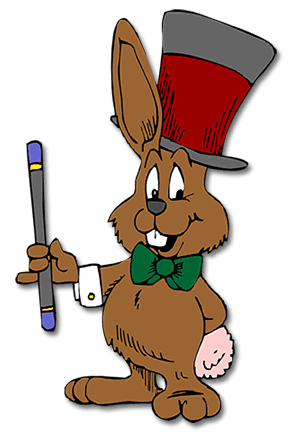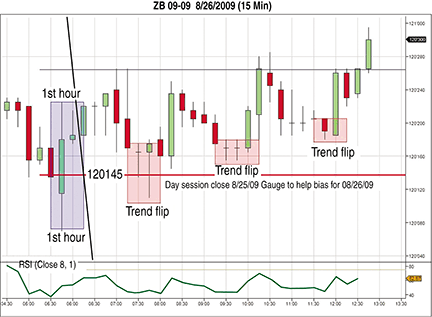AT THE CLOSE
The First-Hour Magic
It’s that time of the trading day when anything and everything is possible…

It’s a little past 5 am Pacific time and I am ready to trade the US commodity futures session. It’s early, but my day is going to end around 8 am. I can live with that! I have a lot of inner chatter going on because it’s 5:19 and it’s one minute to game time. It’s time for my morning ritual to calm my inner chatter: “If I follow my game plan, I am a great trader! If I adjust to my opponent, I am an experienced trader! If I follow my game plan and adjust to my opponent when necessary, I am a master trader!”
Adjusting to your opponent
The essence of this article is captured in the part of my ritual when I mention “adjusting to my opponent.” Who are my opponents in electronic trading? I can’t see them. As market commentator Rick Santelli points out, “Electronic trading is like playing a game, but you can only watch the scoreboard,” so who are we playing against? When I talk about my opponents in electronic trading, they are either buyers or sellers. When I am a short player (seller first), my opponents are the buyers and my teammates are the sellers. When I am a long player (buyer first), my opponents are the sellers and my teammates are the buyers. I am always interested in the health of both teams.
In this game, I want to play against a weak opponent and play alongside a healthy teammate. Here’s how I break it down.
Importance of technical analysis
As daytraders, we have our key tool in the form of technical analysis, watching charts and graphs that plot price behavior over time. We also use fundamental analysis to build our sense of economic health, but we are such micro players that we tend to play almost entirely technically.
Most technicians concentrate on the four key parts of price over a specific period of time: open, high, low, and close. I add a fifth element, which is the range (high - low = range). This component enables the trader to assess the approximate dollar value of risk over the specific period of time. Never ignore your account value or lose respect for the market’s ability to strip you of every penny and then some.
Of the open, high, low, close, and range components, I want to focus on the importance of the close. Why is the day session closing price so important? Every open position at the end of the day session is marked to this price. As prices oscillate away from this benchmark, open positions are affected. If we move higher from the previous close, long positions are healthy and making money and short positions are feeling pain. On the flipside, when prices fall below the close, short positions are healthy and making money and long positions are feeling pain.
I prefer to choose a healthy teammate. Healthy teammates are vital, because I need them when I exit the trade. Most technicians rely on the closing price to calculate their studies, which is another reason why it is so important. If every study needs it, it is important, so you should know it.
Building your confidence
Here are three steps to build your confidence when trading commodity futures:
Step 1: Health meter. I refer to the previous day’s session close as my “health meter” (the red line on the chart in Figure 1). It tells me to favor long positions when prices are above the health meter and favor short positions when prices are below the health meter. Now, it’s not always wise to just jump on board and bet the farm as prices start to rise or fall from your key level, so I’ll add two more steps to help me play my opponent as efficiently as I can.

Figure 1: the first-hour magic. Here you see the health meter displayed as a horizontal red line, which represents the previous session’s close. The blue box represents trading during the first hour and the red boxes represent areas that the trend flips during the trading day. As long as the trend flips are above the health meter, you are safe going long.
Step 2: Trend flips. Most of you who have been trading for some time realize it is not a profitable venture to try to pick price tops or bottoms. To avoid stepping in front of the “price train” (trying to pick a top) or catching a “falling knife” (trying to pick a bottom), both of which are financially dangerous, I look for trend flips. Instead of jumping in front of the price train, I let prices flip from an uptrend (higher highs and higher lows) to a downtrend (lower highs and lower lows) before going short. If the previous day’s session close is above my head (step 1), my confidence to go short becomes stronger.
On the flipside, instead of trying to catch a falling knife, I let prices flip from a downtrend to an uptrend before going long (the red box on the chart). If the previous day’s session close is below my feet (step 1), my confidence to go long becomes stronger.
Step 3: First-hour magic. As the day gets under way, trading coaches will tell you some adjustments have to be made to their game plans as the action unfolds. The best part of trading commodity futures is that you don’t have to be loyal to one particular side during the game. You can be on the long team (buy first) or the short team (sell first) whenever you see an opportunity.
During the first hour of the US trading session (5:30 am–6:30 am Pacific), the most vibrant economic reports are released and every player is jumping out of their skin to participate. Buys and sells accumulate generally at their greatest rate during this hour, and then something happens. Somebody begins to win.
As prices push out of the top side of this hour (the blue window on the chart), you get confirmation that the buyers are winning. By using steps 1 and 2 for confidence, you hope that the health meter (the previous close) is under your feet and price action begins to flip back from a downtrend to an uptrend after we see a push above the first-hour high.
Well, it’s already 8:15 am Pacific on the chart — I’m working overtime. Time to go for a run…regenerate for tomorrow’s session.